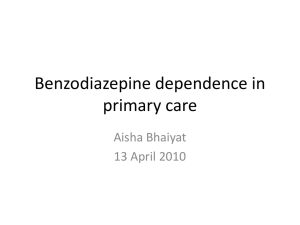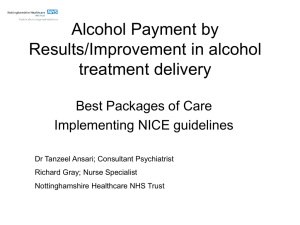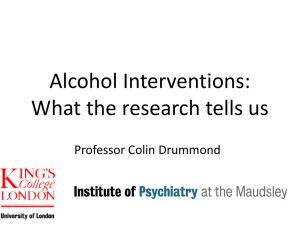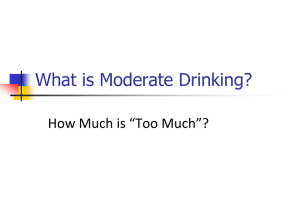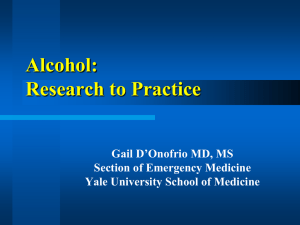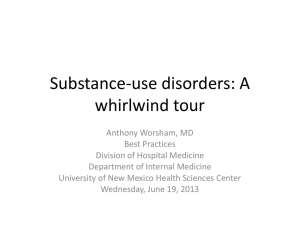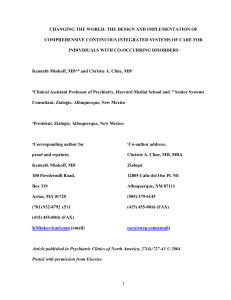Inpatient treatment and care of people
advertisement
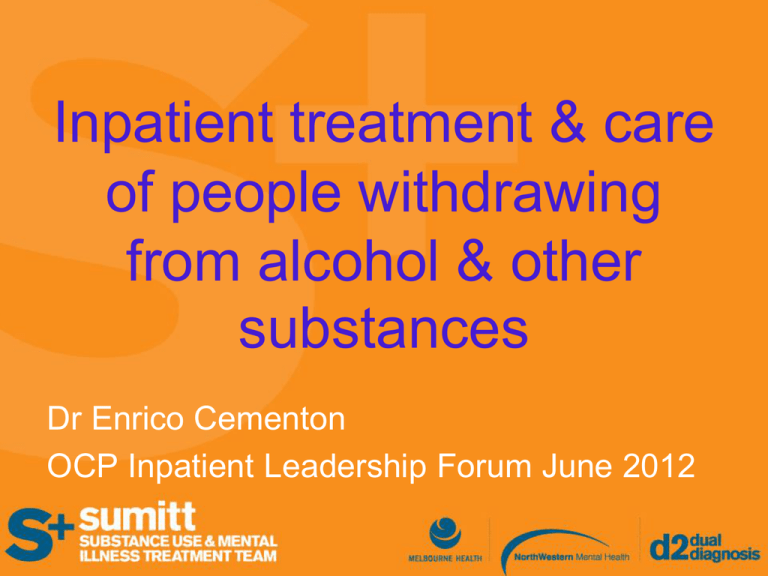
Inpatient treatment & care of people withdrawing from alcohol & other substances Dr Enrico Cementon OCP Inpatient Leadership Forum June 2012 You’ll also find it at: NWMH AOD Withdrawal Management Guidelines intranet site Executive summary • 41 inpatient deaths, 29 most likely suicide • 13 after absconding from IPU – At least 2 OD opiates • 2 in ED with dual diagnosis • Management of co-morbid substance use a key theme – Opiates implicated in 4 deaths – Drug-seeking a motivation for absconding – Lack of intervention-planning for AOD SUMITT Clinical Review Audit Start 2001 to end 2004 • 212 patients – 41 (19%) re-referred during 4-year period • 4 deaths – All Dx psychosis & depression – 3/4 OD multiple substances including heroin; 4th opioid dependence DD in 15 Recommendations DD in 15 Recommendations Dual Diagnosis • Co-occurrence of mental health & substance use disorder • Narrowed definition in MH literature of serious mental illness & substance use disorder Implications of comorbidity • Poorer prognosis • Poor Rx compliance • Repeated hospitalisation • Problems with rehabilitation • Suicide e.g. Drake et al (1996) • • • • Homelessness Violence Imprisonment Early mortality e.g. McEvoy (2000) .Time……. …….Time…… …….Time…….. …….Time…… …….Time…….. Exclusion Criteria ‘NOT OUR BUSINESS!’ ‘multi-agency, Joint -ISP’ INTEGRATED TREATMENT Routine SCREENING DDx / comorbidity capability spectrum Little recognition of co-occurring disorders 1. 2. ‘1-stop shop’ INTEGRATED TREATMENT Routine INTEGRATED ASSESSMENT 3. 4. Gary Croton SUMITT 5. NO WRONG DOOR Service system 6. 7. Darren Bate 8. 9. 10. What does this “integrated” really mean? • Awareness that co-occurrence is frequent, nor by chance • Always a relationship between disorders affects outcomes • Recognition that effective responses to people with either mental illness or AOD disorders are compatible SAMSA’s Co-occurring Center for Excellence (2007) SUMITT Detection of substance use in MHS • Frequent under-detection • Suspect when – – – – Frequent DNA’s Poor Rx adherence Mental state instability Social/financial/legal problems • Obtain collateral information – Family, carer, case manager – Ix: bloods & UDS/GCMS Green et al (2007) Assessment Process Every client Tobacco Caffeine If Positive CAGE-AID Comprehensive Dual Diagnosis Assessment Clinical Observation If negative Continue mental health assessment Integrated Dual Diagnosis Treatment Plan SUMITT Assessment – Alcohol Use Recommended Drinking Guidelines Guideline 1 Reducing the risk of alcohol-related harm over a lifetime. For healthy men and women, drinking no more than two standard drinks on any day reduces the lifetime risk of harm from alcohol-related disease or injury Guideline 2 Reducing the risk of injury on a single occasion of drinking* For healthy men and women, drinking no more than four standard drinks on a single occasion reduces the risk of alcohol-related injury arising from the occasion. * A single occasion of drinking refers to a sequence of drinks taken without the blood alcohol concentration reaching zero in between. Assessment – Alcohol Use Recommended Drinking Guidelines Guideline 3 Children and young people under 18 years of age. - - Parents and carers should be advised that children under 15 years of age are at the greatest risk of harm from drinking and that for this age group, not drinking alcohol is especially important. For young people aged 15-17 years, the safest option is to delay the initiation of drinking for as long as possible. Guideline 4 Pregnancy and breastfeeding - For women who are pregnant or planning a pregnancy, not drinking is the safest option. For women who are breastfeeding, not drinking is the safest option. ‘A Standard Drink’ SUD Diagnoses • DSM-IV – Substance Use disorders • Substance Abuse • Substance Dependence – SubstanceInduced disorders • ICD-10 (F10-19) – Harmful use (Fx.1) – Substance dependence (Fx.2) – SubstanceInduced disorders follow (Fx.3-9) Multiple diagnoses • List all applicable diagnoses – both substance use & substanceinduced • List separately if Dependence diagnoses met for different drug classes • Once criteria for Dependence met, can never have diagnosis of Abuse for that drug class • ‘Polysubstance abuse’ does not exist! SUMITT Models of comorbidity treatment • 1. Integrated • 2. Sequential • 3. Parallel 1. Integrated treatment • Mental health treatments and substance abuse treatments are brought together : – same clinicians/support workers, or team of clinicians/support workers – same program – to ensure a consistent explanation of illness/problems and a coherent prescription for treatment rather than a contradictory set of messages from different providers • Developing evidence base • Regarded as current best practice 2. Sequential treatment • One treatment (either mental health or substance abuse) followed by the other treatment • first deal with one set of problems and then the other • for comorbid anxiety/mood-substance use disorders • eg. 1° alcoholism 2 ° depression 3. Parallel treatment • concurrent treatment of both the psychiatric disorder(s) and substance use disorder(s) by two separate agencies, BUT: – different goals eg. abstinence vs. harm min – different methods eg. confrontation vs. clientcentredness; assertive case management vs. personal responsibility – exclusion of particular groups of comorbidity – disputes over prime clinical responsibility 3. Parallel treatment .Time……. …….Time…… …….Time…….. …….Time…… …….Time…….. Exclusion Criteria ‘NOT OUR BUSINESS!’ ‘multi-agency, Joint -ISP’ INTEGRATED TREATMENT want to know Routine SCREENING But we about withdrawal management ! DDx / comorbidity capability spectrum Little recognition of co-occurring disorders 1. 2. ‘1-stop shop’ INTEGRATED TREATMENT Routine INTEGRATED ASSESSMENT 3. 4. Gary Croton 5. NO WRONG DOOR Service system 6. 7. Darren Bate 8. 9. 10. Inpatient integrated treatment of dual diagnosis patients 1. Stabilisation of acute medical conditions 2. Detoxification: • • withdrawal Sx Prevent serious complications • DT’s, seizures, exacerbation of psychosis, death 3. Concurrent psychiatric Rx Substance withdrawal • Substance - specific • Maladaptive behavioural change – physiological & cognitive • Due to cessation or reduction after • Heavy & prolonged substance use • S&S usu. opposite of intoxication DSM-IV-TR (2000) effects “Detoxification” • Clearing of toxins • Management of the withdrawal syndrome – Prediction or early recognition crucial → Prevention of, or urgent intervention in, potential medical/psychiatric emergency Acute substance withdrawal in psychiatric patients • Typically unpleasant symptoms – Physiological, Psychological, Cognitive • Exacerbation of underlying or associated conditions → confused clinician! • Potentially serious medical conditions: – Dehydration, electrolyte imbalance, cardiovascular instability, infection – Seizures, delirium Goals of detoxification 1. Provide safe withdrawal → patient drug-free 2. Provide humane treatment & protect patient’s dignity 3. Prepare patient for ongoing treatment of drug dependence Pharmacological strategies in withdrawal management 1. Suppress withdrawal with crosstolerant Rx – Usu. with longer-acting drug 2. Withdrawal reduction by altering another neuropharmacological process: “Symptomatic management” 3. Maintenance of other psychotropic Rx What if the withdrawal does not proceed well? • Much individual variation • Continuous re-assessment required • Check withdrawal Rx dosing – If inadequate → ↑ dose – If adequate → consider other, non-addictive Rx e.g. antipsychotic for agitation, anxiety – NB. Consider drug interactions & sideeffects • Consider possibility of acute medical problem What medication prescribing regime is followed? Plan post-withdrawal management • Engagement in detoxification • Evidence of long term benefits & reduced relapse rates – Pharmacotherapy options – Support & counselling – Relevant information & resources • Advise reduced tolerance → risk of OD • Avoid maintenance benzodiazepines Other issues in PharmacoRx • Interactions – Pharmacokinetic & Pharmacodynamic – Risks: • OD, sedation, drowsiness, impaired coordination – Avoid maintenance benzodiazepines • Consider Rx specific to D&A field – Anticraving Acamprosate, Naltrexone – Substitutions Methadone, Buprenorphine (Suboxone, Subutex) – Disulfiram ‘renaissance’ Opiate Dependence • Opioid use, especially heroin, confers particular risks for morbidity & mortality – Sedation, respiratory depression, OD – Especially when combined with other drugs e.g. alcohol, benzo’s, antidepressants, antipsychotics – Also general risks associated with IVDU e.g. local infection, blood-borne virus • Will require consultation +/- referral to local AOD service or DACAS (Ph: 9416 3611) SUMITT Revisit old ideas for our IPUs? • Breathalysers • Needle disposal boxes • Rapid result UDS SUMITT Conclusions • Comorbidity or “dual diagnosis” as the expectation • Co-occurring, long-term, chronic relapsing disorders – Cycles of remission & relapse as part of recovery ! – Cycles not necessarily synchronized → Implications for interventions’ matching • Legacy of separate MH & AOD systems – Barriers to integrated assessment & treatment Last messages • Record all MH & SUD diagnoses • Integrated treatment – Current best practice – Consider all presenting MH & substance use problems as primary – Compatibility of responses to DD • Withdrawal management or detox is only the start of the addiction recovery process! SUMITT So let’s move onto the next step in the change process to dual diagnosis capability … Integrated & treatment ! Thank you Enrico.Cementon@mh.org.au Resources • Drug & Alcohol Clinical Advisory Service (DACAS) Ph: 9416 3611 • Directline Ph: 1800 888 236 • Family drug help Ph: 1300 660 068 • Drug Health Services, Western Health (previously DAS West) Ph: 8345 6682 • DPU Ph:1300 364 545 • Medicare Prescription Shopping Program Ph:1800 631 181 • Reconnexion Ph: 1300 273 266 • SUMITT Ph: 8387 2202

